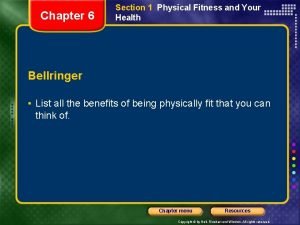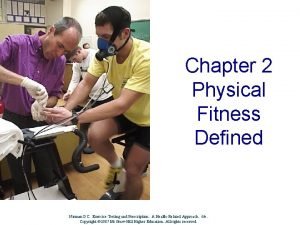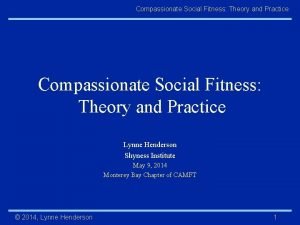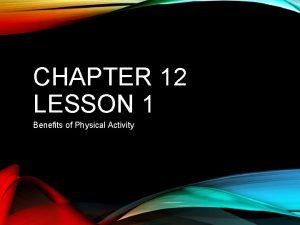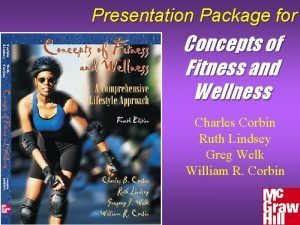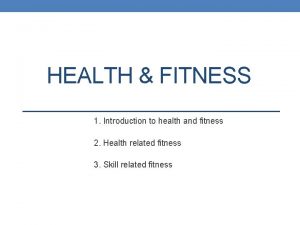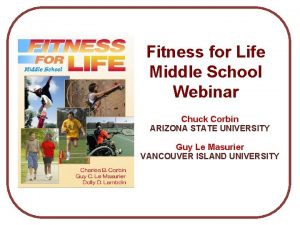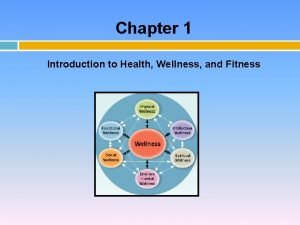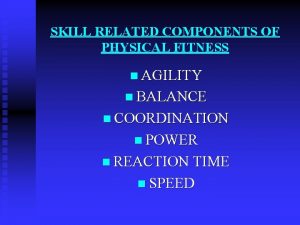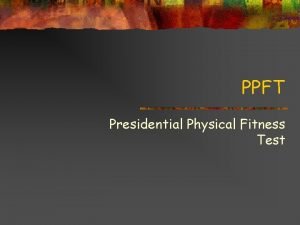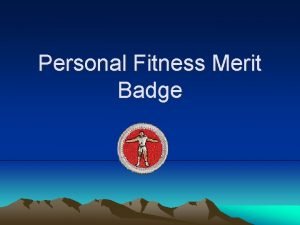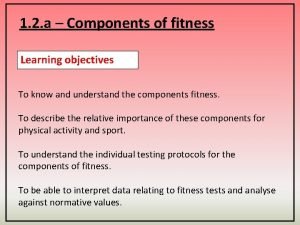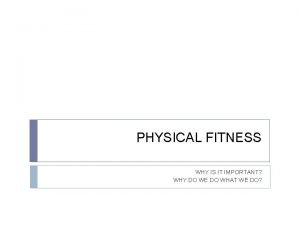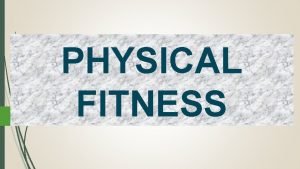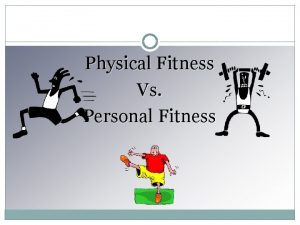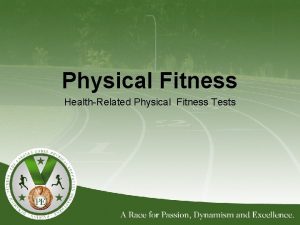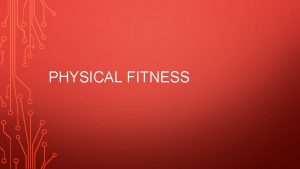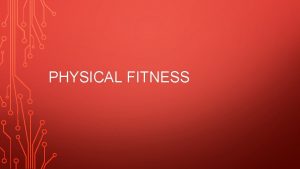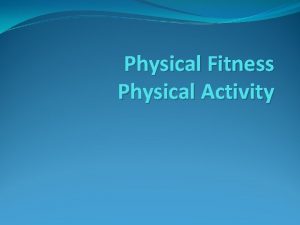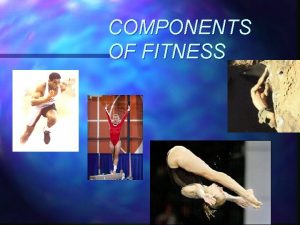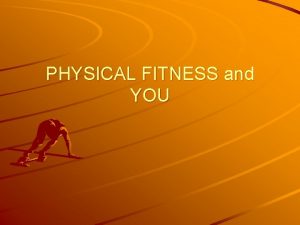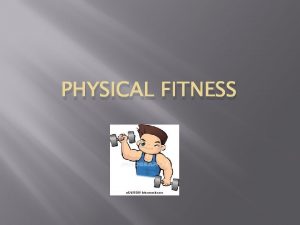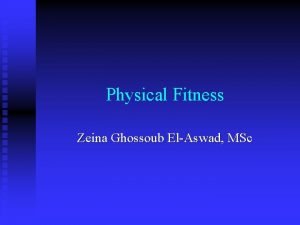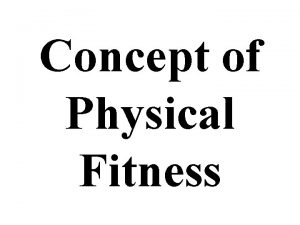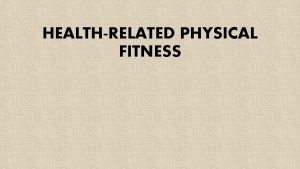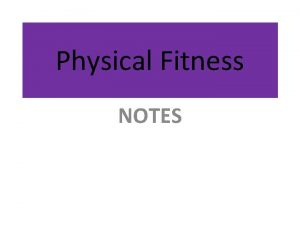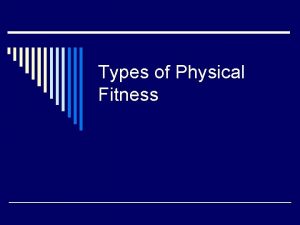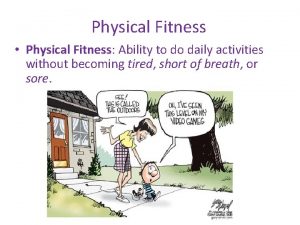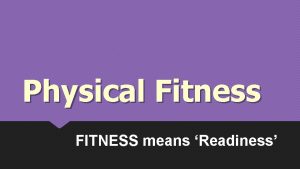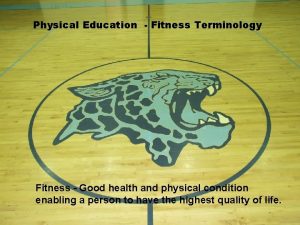Physical Fitness What is Fitness and Health FITNESS

























- Slides: 25

Physical Fitness

What is Fitness and Health FITNESS: - The ability to carry out daily tasks with vigour and alertness without undue fatigue and with ample energy to enjoy leisure time pursuits and to meet unforeseen emergencies. HEALTH: - A state of complete physical, social and mental wellbeing, and not merely the absence of disease or illness.

Components of Health Physical well being: Your heart, lungs and other body systems are working well and you have no illnesses or injuries. Mental well being: You are able to cope with stress. You are able to control your emotions even if you feel very angry you don’t get violent. You feel positive about your self (you have selfesteem). Social well being: You have enough to eat, clothing and shelter (basic human needs). You have friendship and support. You feel you have some value in society.

Physical Fitness is generally defined as a set of abilities that an individual possesses in order to perform specific types of physical activity efficiently and effectively. The components of Physical Fitness may be categorised into: Performance related fitness components Health related fitness components.

Components of Fitness -Health Related Body composition: Is the ratio of lean body mass to fat. Cardiovascular Endurance (aerobic fitness): Is the ability to exercise continuously for extended periods without tiring, and is an important component of many sporting activities. Muscular strength: Is the ability of your body's muscles to generate maximum amount of force in a short period of time utilizing anaerobic energy.

Components of Fitness -Health Related Muscular endurance: Is the ability of a muscle or muscle group to do repeated contractions against a less-thanmaximum resistance for a given time. Flexibility: Is the ability of a joint to move freely through the entire range of motion without pain or discomfort.

Components of Fitness -Skill Related Balance: Refers to your ability to maintain or regain upright posture or equilibrium, while moving (dynamic) or standing still (static). Co-ordination: Is the ability to use the senses of vision and touch together with kinetics to accomplish accurate, well-timed body movements. Reaction Time: Means the amount of time it takes to start moving once a person decides to move.

Components of Fitness – Skill Related Power: The ability to exert maximum muscle contraction instantly in an explosive burst of movement (jumping or sprint starting). Speed: Is your ability to perform a movement over a distance in a short time. Agility: Is your ability to change the position of the whole body quickly and without damaging the ligaments and tissues.

Developing Physical Fitness F. I. T. T Principle

Developing physical fitness Safety is an important consideration for people commencing an exercise regime. Prior to starting an exercise program, everyone should complete a pre-exercise screening questionnaire. This provides information on medical conditions, injury, exercise history and goals. It also identifies individuals who require medical clearance before commencing a program.

The following factors should be taken into account when planning an individual program, as each can affect the type, amount, and difficulty of the exercise. • • • Preference Goals Ability Age gender Exercise history

Improving Fitness The basic principles to improve fitness are summed up in the acronym F. I. T. T Frequency - how often you train. Intensity - how hard you train. Time - how long you train. Type - the type of training

The F. I. T. T principle Cardiorespiratory Endurance Muscular Strength Muscular Endurance Frequency 3 - 5 times per week Intensity 60 - 90% MHR 3 - 7 MR 12+ MR Time 20 minutes or more Time required to do 3 - 7 repetitions of each exercise Time required to do 12+ repetitions of each exercise Type Running Swimming Rowing Bicycling Jumping Rope Walking MHR = Max Heart Rate Free Weights Resistance Machines Body-Weight Exercises (Push-ups/Situps/Pull-ups/Dips, etc. ) MR = Max Repetitions

Principles of Training Designing a Training Program

Principals of Training Specificity - Training, to be effective, must be targeted at the specific sport in which the individual is participating. Marathon runner Dominate energy system = aerobic Fitness component = cardiorespiratory endurance Muscle group = leg muscles • Therefore include continuous long distance running and also some light weight training activities that concentrate on the legs.

Principals of Training Warm-up and cool-down – It is important to do a warmup and cool down so your body is physically prepared by increasing blood flow to the muscles as well as increasing body temperature and respiration rates. The warm up has two purposes: 1. Mentally prepares athlete for event by blood flow to muscles, body temp and breathing rates. 2. Chances of injury, as muscles are warmed up and stretched. Warm up should include a light jog, stretching, and sport specific warm up, and should last 15 mins.

Principals of Training Cool down • Should last 5 -10 mins. • Should consist of active recovery(jog), to allow for the removal of lactic acid, heart rate and body temp. • Stretch.

Principals of Training Variety – Use a variety of training methods to prevent boredom and overuse injuries. A creative coach can adapt training schedules to include variety, while ensuring athletes still focus an their specific needs. Example: changing training from the track, to the beach.

Principals of Training Overload - Is the gradual increase in physical activity to stress a muscle group or body system beyond accustomed levels. For example if you were a competitive runner, you would need to add more distance as you trained, or increase the speed of your set distance. Although overload is necessary to improve physical fitness and skills level, this overload has to be progressive.

Principals of Training Reversibility - "If you don't use it, you lose it". Unfortunately, the body seems to lose muscle much more quickly than it is gained. A general ratio is 3: 1, missing one week's training requires three weeks to get back to the same level. Pre-season training is about regaining lost fitness levels after time off. This can happen in as little as two weeks.

Measurement & Evaluation

Measurement and Evaluation Fitness testing and measurement are valid tools for coaches in allowing them to plan and evaluate highly successful training programs that meet the specific needs of their athletes. Fitness testing provides the following: - Motivation Diagnosis and prescription Selection for teams Determination of grades Program evaluation Construction of norms and scoring scales

Pre-exercise screening • What sort of information should be asked of clients about to embark on a training or exercise program? • Look at the various examples of questionnaires around the room. What are the common questions asked? • You are the gym manager at a new gym. You are required to design the pre-exercise screening program.

Measurement and protocols

Interpreting and processing results Norms are used to compare fitness test scores between those who have undergone the same test. It is important when comparing your fitness test scores to norms, that you determine the validity of these norms. For example, it is not valid for a 16 year old male to compare his scores to norms developed for 18 year old males.
 Health related fitness and skill related fitness
Health related fitness and skill related fitness Physical activity and physical fitness assessments grade 9
Physical activity and physical fitness assessments grade 9 Fitness chapter 6
Fitness chapter 6 Health related physical fitness definition
Health related physical fitness definition Social fitness training
Social fitness training What is physical fitness in mapeh
What is physical fitness in mapeh What are the two types of physical components
What are the two types of physical components Chapter 12 physical activity and fitness
Chapter 12 physical activity and fitness Chapter 3 benefits of physical activity
Chapter 3 benefits of physical activity Health and fitness presentation
Health and fitness presentation Introduction of health and fitness
Introduction of health and fitness Wolters kluwer
Wolters kluwer Stairway to lifetime fitness health and wellness
Stairway to lifetime fitness health and wellness Vcert health and fitness
Vcert health and fitness Stairway to lifetime fitness health and wellness
Stairway to lifetime fitness health and wellness Coaching activity introduction to health and wellness
Coaching activity introduction to health and wellness Health and social care component 3
Health and social care component 3 Physical rate fences example
Physical rate fences example Skill related fitness agility
Skill related fitness agility Presidential physical fitness test
Presidential physical fitness test Boy scout physical fitness merit badge
Boy scout physical fitness merit badge Where is the starting point for hexagon agility test?
Where is the starting point for hexagon agility test? Ruler drop normative data
Ruler drop normative data Physical fitness
Physical fitness Fitness is defined as
Fitness is defined as Definition of physical activity
Definition of physical activity


